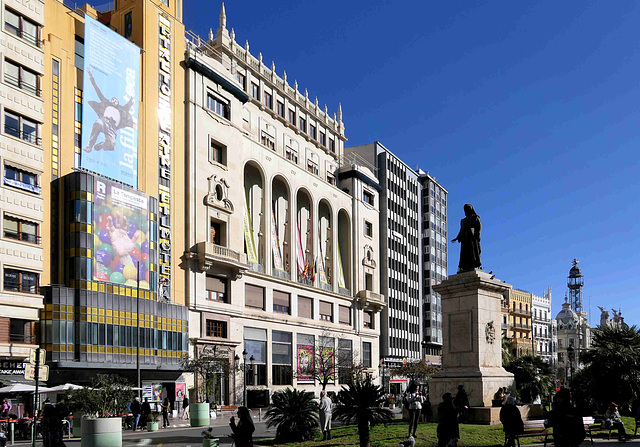Valencia - Mercado Central
Valencia - Mercado Central
Valencia - Fuente del Turia
What A Wonderful World
Cordoba Andalucia Spain 11th November 2023
Du coté de Granada en Espagne..
Maman
Plaza de Espana in Sevilla
Cordoba Andalucia Spain 10th November 2023
HWW Alhambra Granada Spain 8th November 2023
Tarragona, 48
Tarragona, 50
La Pineda (Tarragona), 1
Sevilla - Real Alcázar de Sevilla
Sevilla - Shoes
HWW Cordoba Andalucia Spain 11th November 2023
Tarragona, 58
Tarragona, 69
La Pineda (Tarragona), 2
HBM Cordoba Andalucia Spain 11th November 2023
Granada Spain 9th November 2023
Tarragona, 70
Tarragona, 71
Valencia - Plaza del Ayuntamiento
Valencia - Plaza del Ayuntamiento
Valencia - Estacion del Norte
Valencia - Plaza de Toros
Valencia - Catedral de Santa María
Tarragona, 13
Tarragona, 12
Tarragona, 9
Salou (Tarragona), 45
Tarragona, 7
Teruel
Daroca - Puerta Baja
Luco de Jiloca - Puente romano
Teruel - Aeroporto
Calpe Valencia Spain 15th November 2023
Mojacar Andalucia Spain 12th November 2023
Sigüenza - Catedral de Santa María
Tarragona, 4
Tarragona, 3
Sigüenza - Catedral de Santa María
Medioevo a Santa Pau
Guadalajara - Santa María de la Fuente la Mayor
Location
Lat, Lng:
You can copy the above to your favourite mapping app.
Address: unknown
You can copy the above to your favourite mapping app.
Address: unknown
Keywords
Authorizations, license
-
Visible by: Everyone -
All rights reserved
-
92 visits
Valencia - Plaza del Ayuntamiento


According to the Roman historian Titus Livius "Valentia" was founded by Consul Decimus Iunius Brutus Callaicus in the 4th century BC,
A century later "Valentia Edetanorum" became one of the first Hispanic cities to become a Roman colony.
The city made rapid progress after the Arab conquest in 711, reaching 15,000 inhabitants in the Caliphate of Córdoba. The Amirids and the Dhun Nunids ruled in “Balansiya”. In 1094, El Cid, a Castilian noble, conquered the city. The conquest was not carried out on behalf of one of the Christian kingdoms, but on the Cid's own account, who proclaimed himself "Señor de Valencia" and thus created a kind of private kingdom. He was able to defend the city against several Almoravid attacks, and after his death in 1099, his widow Jimena managed to hold Valencia until 1102, when it fell to the Almoravids, and a little later to the Almohads.
After the victory of the united Christian armies over the Almohads in the Battle of Las Navas de Tolosa (1212), Moorish Spain fell apart again into individual small kingdoms, including a Taifa from Valencia.
It was finally conquered in 1238 by Jaime I de Aragón (aka "el Conquistador"), after a five-month siege.
In the 15th century, the city grew rapidly and developed into one of the largest Mediterranean ports and an important trade and financial center. At the beginning of the 15th century the city had around 40,000
The Plaza del Ayuntamiento is probably the most important and central square. All around are buildings in an eclectic, modernist, and rationalist style, built in the first half of the 20th century.
A century later "Valentia Edetanorum" became one of the first Hispanic cities to become a Roman colony.
The city made rapid progress after the Arab conquest in 711, reaching 15,000 inhabitants in the Caliphate of Córdoba. The Amirids and the Dhun Nunids ruled in “Balansiya”. In 1094, El Cid, a Castilian noble, conquered the city. The conquest was not carried out on behalf of one of the Christian kingdoms, but on the Cid's own account, who proclaimed himself "Señor de Valencia" and thus created a kind of private kingdom. He was able to defend the city against several Almoravid attacks, and after his death in 1099, his widow Jimena managed to hold Valencia until 1102, when it fell to the Almoravids, and a little later to the Almohads.
After the victory of the united Christian armies over the Almohads in the Battle of Las Navas de Tolosa (1212), Moorish Spain fell apart again into individual small kingdoms, including a Taifa from Valencia.
It was finally conquered in 1238 by Jaime I de Aragón (aka "el Conquistador"), after a five-month siege.
In the 15th century, the city grew rapidly and developed into one of the largest Mediterranean ports and an important trade and financial center. At the beginning of the 15th century the city had around 40,000
The Plaza del Ayuntamiento is probably the most important and central square. All around are buildings in an eclectic, modernist, and rationalist style, built in the first half of the 20th century.
kiiti, Fred Fouarge, Paolo Tanino have particularly liked this photo
- Keyboard shortcuts:
Jump to top
RSS feed- Latest comments - Subscribe to the comment feeds of this photo
- ipernity © 2007-2025
- Help & Contact
|
Club news
|
About ipernity
|
History |
ipernity Club & Prices |
Guide of good conduct
Donate | Group guidelines | Privacy policy | Terms of use | Statutes | In memoria -
Facebook
X

Sign-in to write a comment.